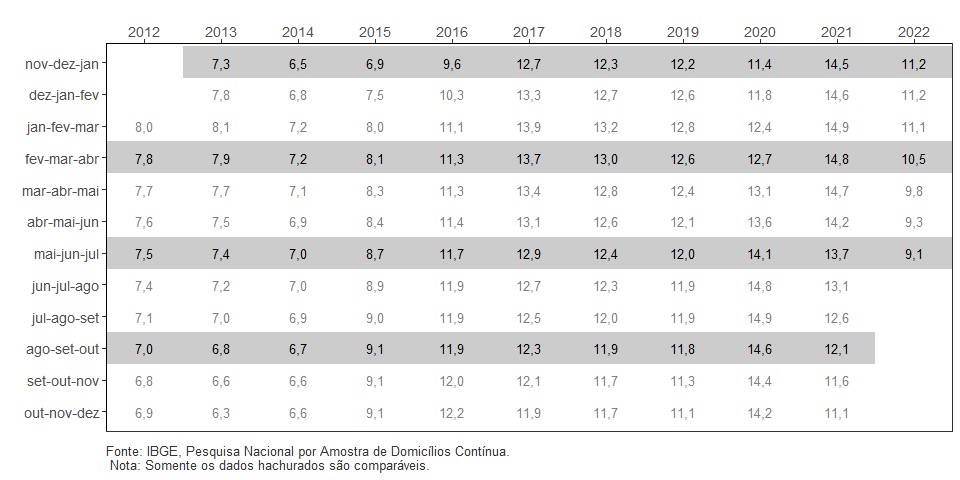Continuous PNAD: unemployment rate is 9.1% and underutilizationn rate hits 20.9% in the quarter
August 31, 2022 09h00 AM | Last Updated: September 01, 2022 01h10 AM
The unemployment rate (9.1%) of the moving quarter May-July 2022 dropped 1.4 percentage points (pp) against the quarter February-April 2022 (10.5%) and 4.6 pp against the same period in 2021 (13.7%). The unemployed population (9.9 million persons) fell to the lowest level since the quarter ended January 2016, having dropped 12.9% (by 1.5 million persons) in the quarter and 31.4% (by 4.5 million) in the year.
| Indicator/Period | May-Jun-Jul 2022 | Feb-Mar-Apr 2022 | May-Jun-Jul 2021 |
|---|---|---|---|
| Unemployment rate | 9.1% | 10.5% | 13.7% |
| Underutilization rate | 20.9% | 22.5% | 27.9% |
| Usual real earnings | R$ 2,693 | R$ 2,618 | R$ 2,773 |
| Change of the usual earnings in relation to: | 2.9% | -2.9% | |
The number of employed persons (98.7 million) ) was a record in the time series started in 2012, with a high of 3.1% (3.0 million more) against the previous quarter and of 9.9% (8.9 million more persons) against the same period of 2021. Estimated at 57.0%, theemployment-population ratio percentage of employed persons in the population at working age - grew 1.1 p.p in the quarter (55.8%) and 4.1 p.p fromr the same quarter in 2021 (52.8%).
Thecompound underutilization rate (20.9%) was the lowest since June 2016 (20.9%), having fallen 1.6 p.p in the quarter and 7.0 pp in the year. The underutilized population (24.3 million persons) dropped 6.9% (-1.8 million persons) in the quarter and 24.0% (-7.7 million persons) in the year.
Thetime-related underemployed population (6.5 million) stood stable against the previous quarter and decreased 17.1% in the year (-1.3 million persons) in the year.
The population out of the labor force (64.7 million persons) remained stable against the previous quarter and dropped 2.8% (by 1.9 million persons) in the annual comparison.
The discouraged population (4.2 million persons) fell by 5.0% from the previous quarter (by 221 thousand persons) and 19.8% (by 1.0 million persons) in the annual comparison. The percentage of discouraged persons in the labor force (3.7%) fell 0.2 p.p. against the previous quarter and 1.0 p. p. against the same quarter a year ago.
The number of workers with a formal employment contract in the private sector (except domestic workers) was 35.8 million persons, having increased 1.6% (555 thousand persons) against the previous quarter and 10.0% (3.3 million persons) in the annual comparison.
The number of workers without a formal contract in the private sector (13.1 million persons) was the highest in the time series initiated in 2012, and recorded an increase of 4.8% in the quarter (601 thousand persons) in the quarter and 19.8% (2.2 million persons) in the year.
The number of self-employed persons was 25.9 million persons. Compared to the previous quarter, there was growth of 1.3% (326 thousand persons), while, in comparison with the same period last year, the increase was 3.5% (872 thousand persons more).
The number of domestic workers (5.8 million persons) remained stable in the quarter and increased 14.1% (718 thousand persons) in the year.
The number of employers (4.3 million persons) increased 3.9% in the quarter (162 thousand persons more) and increased 16.2% (597 thousand persons) in the year. The number of workers in the public sector (12.0 million) grew 4.7% in the quarter and 5.1% in the year.
The informality rate ereached 39.8% of the employed population, against 40.1% in the previous quarter and 40.2% in the same quarter of 2021.
The number of informal workers reached 39.3 million.
Usual real earnings (R$2,652) stood stable against the previous quarter and fell 2.9% in the year. The usual real wage bill (R$260.7 billion) grew 5.3% from the previous quarter and 6.1% in the annual comparison.
Unemployment Rate - Brazil - 2012/2022

Estimated at 108.5 million persons in the moving quarter May-July 2022, the workforce (employed and unemployed persons) increased 0.6% (687 thousand persons) in comparison with the quarter February-April and 3.3% (3.5 million persons) against the same quarter last year. It was the greatest number of persons in the labor force in the survey’s time series.
The following activity groups recorded increases against the previous moving quarter: Trade, repair of motor vehicles and motorcycles (3.7% or 692 thousand persons) and Public administration, defense, social security, education, human health and social services (3.9% or 648 thousand persons). The other groups did not record significant changes.
Against the quarter ended in June 2021, increases were observed in: General Industry (8.2%, or 966 million persons), Construction (7.4%, or 516 thousand persons), Trade, repair of motor vehicles and motorcycles (13.2%, or 2.2 million persons), Transportation, storage and mailing (9.1%, or 430 thousand persons), Lodging and food services (19.7%, or 894 thousand persons), Information, Communication and Financial, Real Estate, Professional and Administrative Activities (3.8%, or 426 thousand persons), Public administration, defense, social security, education, human health and social services (6.9%, or 1.1 million persons), Other services (21.3%, or 913 thousand persons) and Domestic services (13.8%, or 711 thousand persons). agriculture, livestock, forestry, fishing and acquaculture did not record significant changes.
Compound underutilization rate - Quarters May - July – Brazil – 2012 to 2022 (%)

As for theaverage usual real earnings (R$2,693), against the previous moving quarter, there was an increase in Trade, repair of motor vehciles and motorcycles (3.2%, or R$ 70 more) and Public administration, defense, social security, education, human health and social services (2.1%, or R$ 78 more). The other groups did not record significant changes.
As for employment types, against the quarter ended July 2021, the only significant increase was that of Domestic workers (2.7%, or R$ 27 more).

